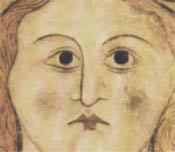|
|

Mosti ryden by Rybbesdale:
introduction
London, British Library, Harley MS 2253, f. 66v

 The
apparently local and individual voice of this poem becomes more impersonal on closer
study. It follows the pattern of a standard exercise in medieval Latin rhetoric, the
description of a woman's beauty. In these exercises, the woman is systematically described
from head to toe (clothes are an optional extra), usually, as here, with a discreet gap in
the middle---although the gap is filled by the fifteenth-century Welsh woman poet Gwerful
Mechain in her erotic poem Cywydd y cedor, which 'suggests that certain parts of
the female body have been left unsung by male poets, but that they merit the same praise
as a woman's hair, eyebrows, and so on' (Lloyd-Morgan (1993)). Most
of the details in the Middle English poem can be paralleled in the model description of a
woman given by the rhetorician Geoffrey of Vinsauf in his Poetria nova (c. 1200-1215),
translated by Nims (1967); the
relevant extract is reprinted in Miller
(1977). The
apparently local and individual voice of this poem becomes more impersonal on closer
study. It follows the pattern of a standard exercise in medieval Latin rhetoric, the
description of a woman's beauty. In these exercises, the woman is systematically described
from head to toe (clothes are an optional extra), usually, as here, with a discreet gap in
the middle---although the gap is filled by the fifteenth-century Welsh woman poet Gwerful
Mechain in her erotic poem Cywydd y cedor, which 'suggests that certain parts of
the female body have been left unsung by male poets, but that they merit the same praise
as a woman's hair, eyebrows, and so on' (Lloyd-Morgan (1993)). Most
of the details in the Middle English poem can be paralleled in the model description of a
woman given by the rhetorician Geoffrey of Vinsauf in his Poetria nova (c. 1200-1215),
translated by Nims (1967); the
relevant extract is reprinted in Miller
(1977).
One notable feature of the Middle English poem is an element of exaggeration
(the neck over nine inches long (44), the forty-five-inch arms (52)); another is a
tendency to discontinuity in the sequence of thought (e.g. 25-36) or even phrasing
(19-22), probably because the poet is having difficulties with the tight constraints of
his chosen verse-form.

|
 The
apparently local and individual voice of this poem becomes more impersonal on closer
study. It follows the pattern of a standard exercise in medieval Latin rhetoric, the
description of a woman's beauty. In these exercises, the woman is systematically described
from head to toe (clothes are an optional extra), usually, as here, with a discreet gap in
the middle---although the gap is filled by the fifteenth-century Welsh woman poet Gwerful
Mechain in her erotic poem Cywydd y cedor, which 'suggests that certain parts of
the female body have been left unsung by male poets, but that they merit the same praise
as a woman's hair, eyebrows, and so on'
The
apparently local and individual voice of this poem becomes more impersonal on closer
study. It follows the pattern of a standard exercise in medieval Latin rhetoric, the
description of a woman's beauty. In these exercises, the woman is systematically described
from head to toe (clothes are an optional extra), usually, as here, with a discreet gap in
the middle---although the gap is filled by the fifteenth-century Welsh woman poet Gwerful
Mechain in her erotic poem Cywydd y cedor, which 'suggests that certain parts of
the female body have been left unsung by male poets, but that they merit the same praise
as a woman's hair, eyebrows, and so on'